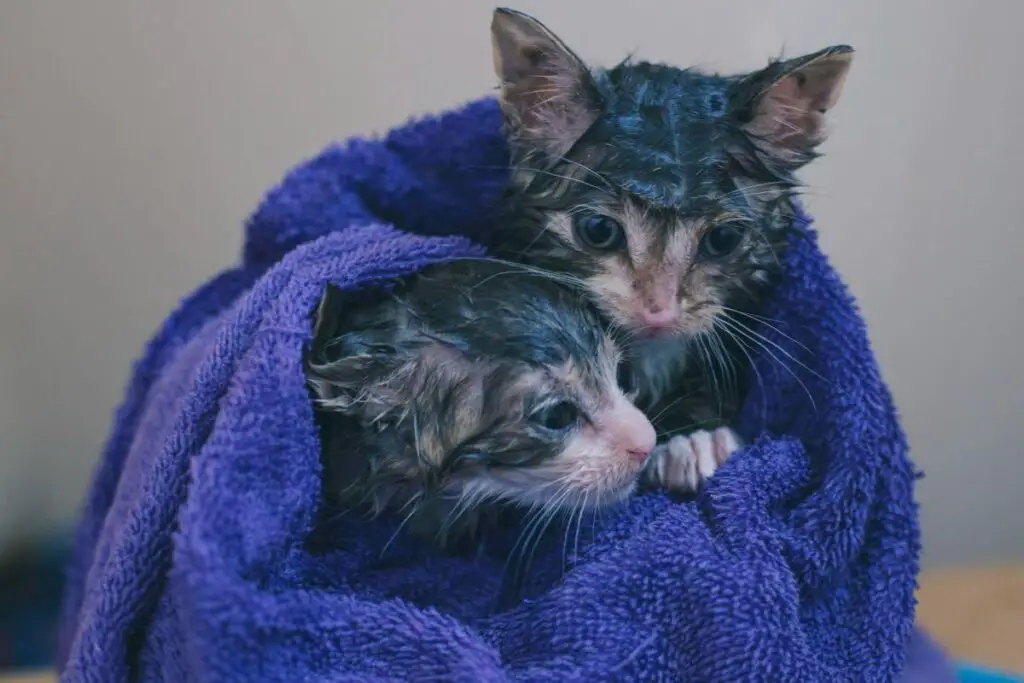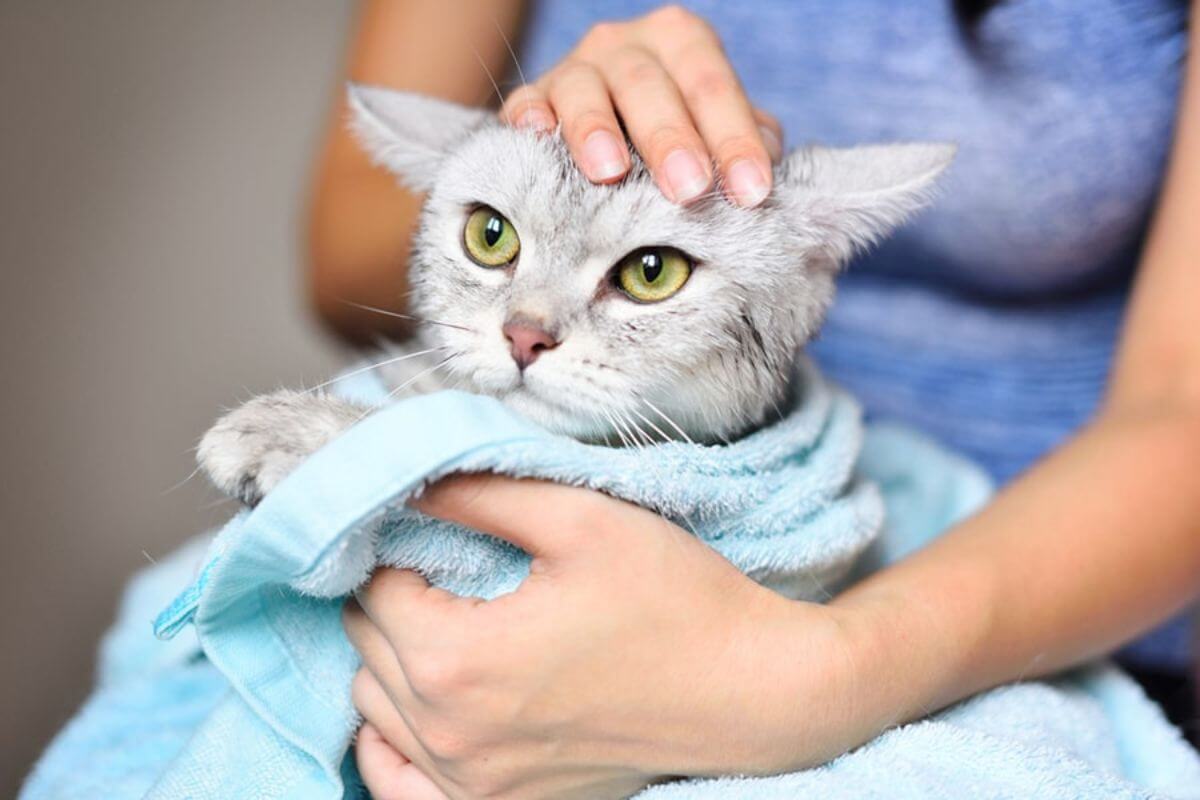Bathing a stray cat may seem like a daunting task, but with patience, gentleness, and a careful approach, it can become a positive experience for both the cat and the caregiver. In this extensive guide, we’ll explore the reasons why bathing may be necessary for stray cats, the step-by-step process to ensure a stress-free bath, and tips on building trust with these resilient feline friends.
I. Understanding the Need for Bathing
Bathing cats may not be a common activity, given their meticulous self-grooming habits. However, certain situations necessitate a bath, and understanding the reasons behind it is crucial for maintaining the health and well-being of our feline companions.
I. Fur Health and Hygiene
A. Matting Prevention
- Bathing helps prevent matting, especially in long-haired breeds. Mats can be uncomfortable for cats and may lead to skin issues if not addressed.
B. Removal of Loose Fur and Dirt
- Cats naturally shed fur, and bathing aids in removing loose hairs and dirt that can accumulate in the coat. This is particularly important for outdoor cats exposed to various elements.
II. Skin Health
A. Parasite Control
- Bathing is an effective method to control external parasites, such as fleas and ticks. Specialized cat shampoos can help eliminate these pests and contribute to overall skin health.
B. Allergen Reduction
- Regular baths can reduce allergens on the cat’s skin and fur, benefiting both the cat and individuals allergic to cat dander.
III. Medical Reasons
A. Treatment of Skin Conditions
- In certain cases, veterinarians may recommend baths as part of a treatment plan for specific skin conditions, infections, or allergies.
B. Medication Application
- Baths provide an opportunity to apply medicated shampoos or topical treatments prescribed by a veterinarian for various skin issues.
IV. Behavioral Reasons
A. Odor Control
- Bathing helps control unpleasant odors, especially in cats with a strong odor or those that may have encountered substances with distinct smells.
B. Prevention of Infections
- Maintaining a clean coat reduces the risk of skin infections, especially in cats prone to conditions like feline acne or dermatitis.
V. Special Considerations for Outdoor Cats
A. Environmental Exposure
- Cats exploring the outdoors may come into contact with various substances, including chemicals, oils, or sticky substances. Bathing helps remove potential toxins and contaminants.
B. Tick and Flea Prevention
- Regular outdoor cats are more susceptible to ticks and fleas. Bathing with anti-parasitic shampoos can aid in preventing infestations.
VI. Preparing for the Bath
A. Choosing the Right Products
- Select cat-specific shampoos and grooming tools. Avoid human products, as they may contain ingredients harmful to cats.
B. Creating a Calm Environment
- Cats are sensitive to their surroundings. Ensure the bathing area is quiet, secure, and equipped with non-slip surfaces to prevent stress.
VII. Bathing Process: A Step-by-Step Guide
A. Wetting the Coat
- Use lukewarm water to wet the cat’s coat thoroughly, avoiding the face. Cats generally dislike water, so a gentle approach is crucial.
B. Applying Shampoo
- Use cat-specific shampoo, lathering it evenly on the coat. Be cautious around sensitive areas like the face and ears. Special attention may be needed for specific skin conditions.
C. Rinsing Thoroughly
- Ensure all shampoo is thoroughly rinsed from the cat’s coat. Residual shampoo can cause skin irritation.
D. Drying Process
- Towel-dry the cat gently, and provide a warm, draft-free area for the final drying process. Some cats tolerate hairdryers on a low, cool setting.

VIII. Post-Bath Care
A. Positive Reinforcement
- Offer treats, praise, or playtime after the bath to create positive associations with the experience.
B. Observing Behavior
- Monitor the cat for any signs of stress, discomfort, or adverse reactions after the bath. Seek veterinary advice if concerns arise.
IX. Balancing Care and Comfort
In conclusion, understanding the need for bathing is an essential aspect of responsible cat ownership. While most cats may not require frequent baths, recognizing situations where bathing is beneficial ensures our feline friends lead healthy, comfortable lives.
So, as you embark on the occasional bath for your cat, may it be a moment of care, strengthening your bond, and contributing to the overall happiness and well-being of your beloved feline companion.
II. Preparing for the Bath
A. Gathering Supplies
Before initiating the bath, assemble all necessary supplies. This includes a mild cat shampoo, a towel, a non-slip mat for the bathing area, and grooming tools like a comb or brush.
B. Creating a Calm Environment
Choose a quiet and secure space for the bath. Stray cats are likely to be nervous, so minimizing noise and creating a calm atmosphere helps reduce stress.
III. Gaining Trust: Gradual Introduction
A. Observing Behavior
Before attempting to bathe a stray cat, spend time observing its behavior. This allows you to gauge its comfort level with human presence and identify any signs of aggression or fear.
B. Gradual Approach
Approach the cat slowly and calmly. Offer treats or food to establish a positive association. Gradually introduce gentle touches to acclimate the cat to human contact.
IV. The Bathing Process
A. Wetting the Coat
Use lukewarm water to wet the cat’s coat. Avoid spraying water directly on the cat’s face, as this can be distressing. A damp washcloth can be used for a more controlled approach.
B. Applying Shampoo
Apply a small amount of cat shampoo, ensuring it’s safe for feline use. Gently lather the shampoo, focusing on areas with dirt or matting. Be cautious around sensitive areas like the face and ears.
C. Rinsing Thoroughly
Thoroughly rinse the cat’s coat to remove all traces of shampoo. Inadequate rinsing can lead to skin irritation. Use a gentle stream of water, and ensure all shampoo is washed away.
D. Towel Drying
After rinsing, wrap the cat in a soft towel to absorb excess water. Patting rather than rubbing helps prevent further stress. Ensure the bathing area remains warm to prevent the cat from getting chilled.
V. Post-Bath Care
A. Offering Treats and Affection
After the bath, offer treats and gentle affection to reinforce positive behavior. This contributes to building trust and making future baths less stressful.
B. Monitoring Health
Observe the cat for any signs of distress or illness after the bath. If there are concerns, seek veterinary attention promptly. Regular baths, when necessary, can be part of an overall health monitoring routine.
VI. Building Long-Term Trust
A. Gradual Socialization
For stray cats becoming accustomed to human care, gradual socialization is key. Spend time with the cat in non-bathing contexts, allowing it to become familiar with human interactions.
B. Consistent Care
Consistency is crucial in building trust. Regular but gentle interactions, along with positive reinforcement, help create a bond between the caregiver and the stray cat.
VII. Conclusion: Compassion in Every Drop
In conclusion, bathing a stray cat is an act of compassion that contributes to their overall health and well-being. By understanding their needs, respecting their boundaries, and employing a patient and gentle approach, caregivers can make the bathing experience a positive one for both themselves and the resilient feline in their care.
So, as you embark on this journey of feline care, may each drop of water signify not just cleanliness but a gesture of kindness, a step towards trust, and a commitment to providing the best possible life for our stray cat companions.
VIII. Special Considerations for Timid Cats
A. Patience is Key
Timid stray cats may require extra patience during the bathing process. Allow them to set the pace, and avoid rushing. Taking breaks between steps, if needed, helps them acclimate to the experience gradually.
B. Soft Spoken Approach
Speak to the cat in a soft, soothing tone throughout the bath. Gentle reassurance through your voice can be remarkably calming, especially for cats unfamiliar with human interactions.
IX. Addressing Matting and Tangles
A. Gentle Detangling
If the cat has mats or tangles, address them with gentle detangling. Use a wide-toothed comb or your fingers to work through knots, taking care not to cause discomfort. Matting can be a source of pain for the cat, and regular grooming post-bath can prevent future issues.
B. Short Sessions
If matting is extensive, consider breaking grooming sessions into shorter, more manageable segments. This prevents overwhelming the cat and allows for gradual improvement in their coat condition.
X. Introducing Positive Associations
A. Treats and Rewards
Incorporate treats and rewards not only after the bath but also during and before the process. Positive associations with treats help create a connection between the bathing experience and enjoyable outcomes.
B. Familiar Objects
Place familiar objects, such as a blanket or a toy, near the bathing area. Familiar scents and items can provide a sense of security, making the cat more comfortable during the bath.
XI. Long-Term Health Benefits
A. Consistent Grooming
Regular grooming, which may include periodic baths, contributes to a stray cat’s long-term health. It helps prevent skin conditions, controls parasites, and ensures their fur remains in good condition.
B. Observing Behavioral Changes
Monitor the cat’s behavior post-bath for any changes. A well-cared-for cat will likely exhibit increased energy, improved coat condition, and a more relaxed demeanor.
XII. Building Trust Through Routine
A. Establishing Routine
Establishing a routine around care activities, including baths, can build a foundation of trust. Cats, especially strays, often thrive on predictability, and a consistent routine helps them feel secure.
B. Gradual Exposure to Water
If a stray cat initially resists water, start with dampening a cloth and gently stroking their fur. Gradual exposure to the sensation of water can make future baths less intimidating.
XIII. Seeking Professional Help
A. Veterinary Assistance
For severely matted or unwell stray cats, seeking professional help is advisable. A veterinarian can provide guidance on the cat’s overall health and offer solutions for grooming challenges.
B. Collaborating with Animal Rescues
Collaborate with local animal rescues or shelters. They may provide resources, advice, or even assistance with grooming and care for stray cats in your community.
XIV. Conclusion: A Bath of Care and Compassion
In conclusion, bathing a stray cat is not just about cleansing their fur but a profound act of care and compassion. It goes beyond the physical cleanliness to create a bond of trust, foster their well-being, and contribute to the shared journey of humans and felines.
So, as you embark on the endeavor of bathing stray cats, may each drop of water symbolize not only cleansing but a nurturing touch, a promise of care, and a step towards a brighter, healthier future for these resilient and deserving feline companions.
Frequently Asked Questions (FAQs) about Bathing Stray Cats
How often should I bathe a stray cat?
The frequency of bathing depends on the cat’s needs and condition. Generally, it’s advisable to bathe a stray cat only when necessary, such as when dealing with severe matting, parasites, or dirt.
What kind of shampoo should I use for a stray cat?
Use a mild, cat-friendly shampoo. Avoid harsh chemicals or human shampoos, as they can be irritating to a cat’s sensitive skin. Consult with a veterinarian for specific recommendations based on the cat’s health.
How can I make the bathing experience less stressful for a stray cat?
Create a calm and quiet environment. Gradually introduce the cat to the bathing area, use a soft, soothing voice, and offer treats as positive reinforcement. Patience and a gentle approach can significantly reduce stress.
Can I use human grooming tools on a stray cat?
It’s recommended to use cat-specific grooming tools, such as combs or brushes. Human grooming tools may not be designed for a cat’s coat and can cause discomfort or harm.
What if the stray cat has severe matting?
For severe matting, it’s advisable to seek professional help. A veterinarian or groomer can provide guidance on how to address matting without causing distress to the cat.
Should I bathe a stray cat during cold weather?
Bathing during cold weather should be avoided, if possible. Stray cats are more vulnerable to temperature changes, and bathing during colder seasons may lead to chilling. Choose milder weather or provide a warm indoor space for post-bath drying.
Can I use regular tap water for bathing a stray cat?
Yes, regular tap water is suitable for bathing stray cats. Ensure the water is lukewarm to prevent discomfort. Using a non-slip mat in the bathing area adds stability and reduces stress for the cat.
How can I prevent the stray cat from scratching or resisting the bath?
Approach the bathing process gradually. If the cat resists, pause and allow them to relax before continuing. Using a calming touch and positive reinforcement, such as treats, can help ease resistance over time.
What signs indicate that a stray cat needs a bath?
Signs such as visible dirt, matting, or evidence of parasites may indicate the need for a bath. Additionally, a cat’s behavior, such as excessive scratching or discomfort, may signal the necessity for grooming.
Is it possible to groom a stray cat without bathing?
In some cases, grooming without bathing may be sufficient. Regular brushing helps remove loose fur, dirt, and prevents matting. Consult with a veterinarian to determine the best grooming approach based on the cat’s specific needs.



